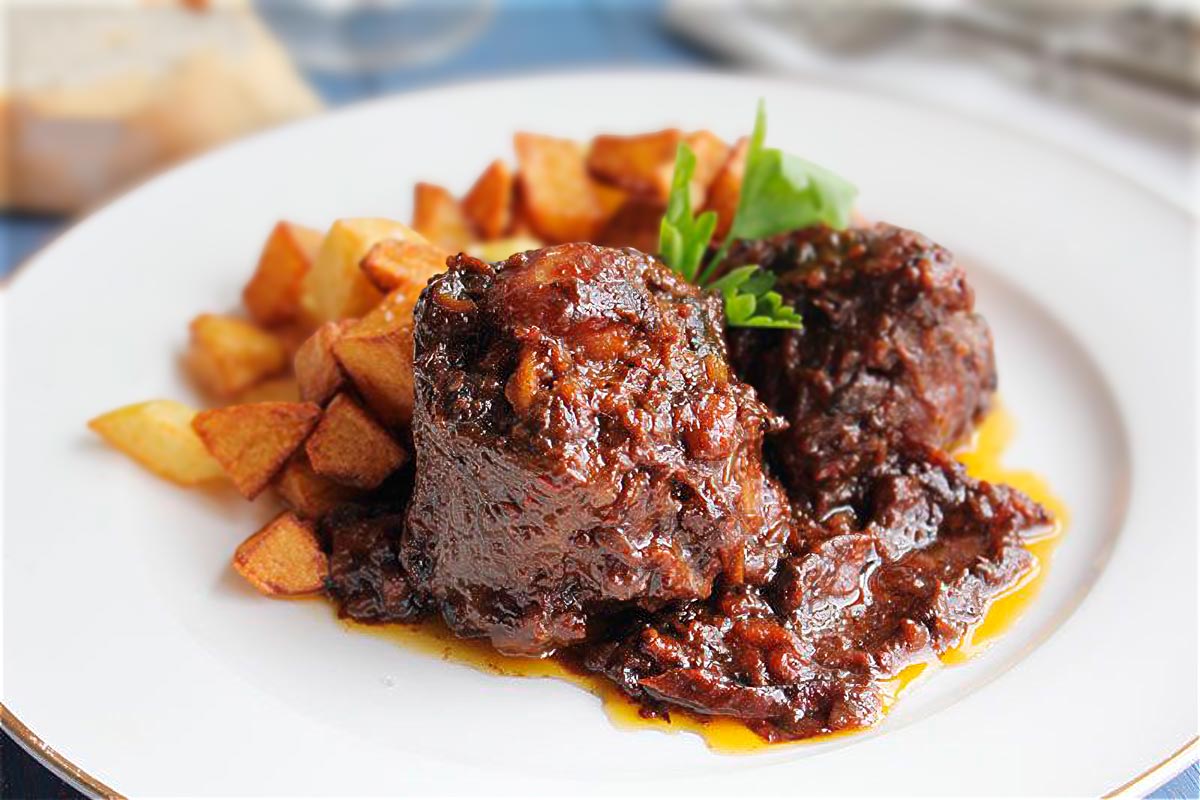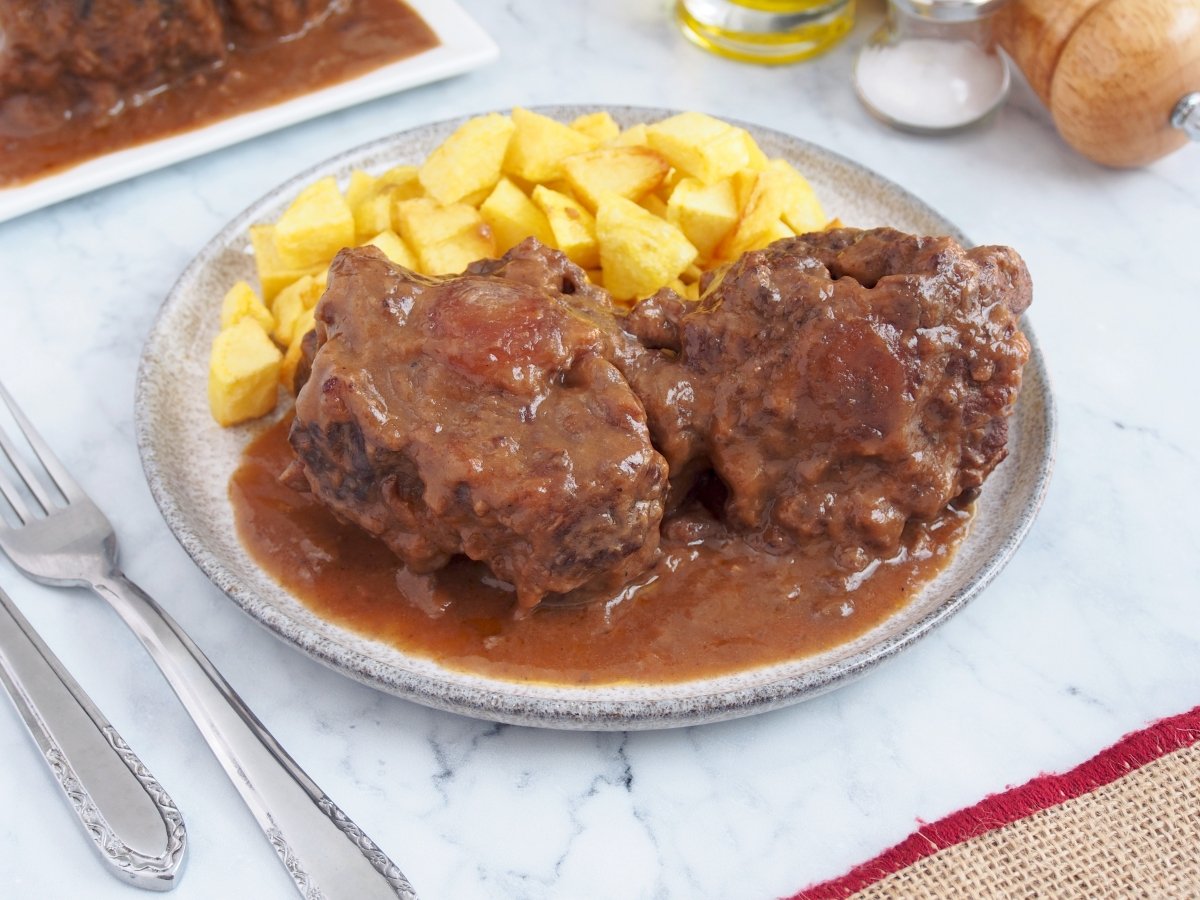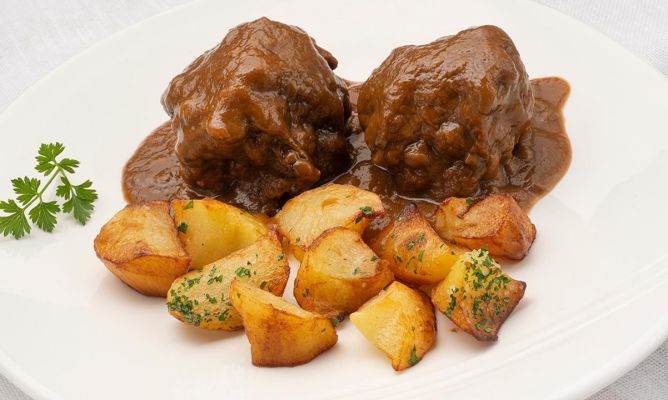On a vibrant expedition through the winding streets and bustling markets of Spain, my palate was graced with the robust flavors of Rabo de Toro, an exquisite dish that is a testament to the depth of Spanish culinary tradition. Esteemed for its tender oxtail (Rabo de Toro), simmered slowly in a rich sauce composed of beef stock and tomatoes, this dish marries simplicity with lavishness. The oxtail, stewed until it falls off the bone, combines with the savory depth of beef stock and the fresh, slightly acidic taste of tomatoes, creating a harmony of flavors that are profoundly satisfying. Enthralled by this discovery, I embarked on a culinary quest to replicate the heartwarming embrace of Rabo de Toro within my own kitchen. Through perseverance and a deep appreciation for the ingredients—Rabo de Toro, beef stock, and tomatoes—I achieved success. It is with great excitement and pride that I now share with you this sumptuous recipe, inviting you to delve into the rich tapestry of Spanish cuisine and experience the comfort and joy Rabo de Toro brings.
Rabo de Toro
Equipment
- 1 pan
Ingredients
- Flour to coat the meat
- Olive oil
- Salt
- Pepper
- 3-4 pounds of Rabo de toro
- 4 cloves
- 4 cloves of garlic
- 2 cups of beef stock
- 1 leek diced
- 2-3 ripe tomatoes
- 1 teaspoon ground ginger
- 1 large sweet onion
- 1 red pepper
- 3 cups of red wine
- 2 bay leaves
- 3 carrots
Instructions
- Using salt and pepper, flavor the bull tail.
- Put a drizzle of olive oil in a big, heavy pan over medium-low heat.
- Generously flour the Rabo de toro and sear each slice in the heated oil for approximately 30 seconds on each side, or until well brown.
- Allow the parts to rest after removing the bull tail.
- Sauté the leek, onions, ginger, garlic powder, and tomato in the pan’s oil for approximately 10 minutes.
- Sauté for 1 minute with the carrots, bay leaves, ginger, and garlic.
- Return the bull tail to the pan and add the wine and water.
- After 3 hours of cooking, check to see whether the Rabo de toro is coming away from the bone.
- If the beef is very hard, it may need a further hour or so.
Cooking tips about Rabo de Toro

- Select Quality Oxtail: The foundation of a great Rabo de Toro lies in the quality of the oxtail. Look for well-marbled pieces as the fat renders down during slow cooking, contributing to the stew’s deep flavors and tender texture.
- Browning is Key: Start by thoroughly browning the oxtail pieces on all sides in a heavy-bottomed pot or Dutch oven. This critical step enhances the flavor of the meat and adds a level of complexity to the stew.
- Slow Cook to Perfection: Rabo de Toro requires patience, benefiting from a long, slow cooking process, which allows the tough fibers in the oxtail to break down, resulting in incredibly tender meat that falls off the bone.
- Rich Sauce Base: The sauce for Rabo de Toro is traditionally made with a robust beef stock and tomatoes, enriched with the aromatic medley of onions, garlic, and a blend of spices such as smoked paprika, bay leaves, and sometimes a touch of cinnamon or chocolate. This combination creates a thick, savory sauce that’s both comforting and complex.
- Wine Adds Depth: Incorporating a good quality red wine into your sauce provides acidity and depth, enhancing the stew’s overall flavor profile. Spanish varieties like Tempranillo or Rioja mirror the dish’s origins and complement the meat’s richness ideally.
- Let It Simmer: After bringing the stew to a boil, reduce the heat and let it simmer gently, uncovered or partially covered. Periodically check and adjust the seasoning as needed, allowing the flavors to meld together harmoniously over several hours.
- Skim Off Excess Fat: As the stew cooks, fat will rise to the surface. Skimming off this excess fat improves the texture and ensures the sauce is rich but not greasy.
- Serve Over a Simple Base: Traditional Rabo de Toro is often served over a simple bed of mashed potatoes or with crusty bread on the side. These bases provide a delicate background that lets the stew take center stage, absorbing the sauce’s flavor without competing with it.
Serving suggestions about Rabo de Toro

- With Rustic Sides: Serve Rabo de Toro alongside rustic, hearty sides such as roasted potatoes, polenta, or a simple loaf of crusty bread to soak up the delicious sauce. These simple accompaniments allow the complex flavors of the Rabo de Toro to shine.
- Paired with Wine: Choose a full-bodied Spanish red wine, such as a Tempranillo or a Ribera del Duero, to complement the richness of the dish. The wine’s depth and character will enhance the dining experience, creating a perfect harmony with the Rabo de Toro.
- Over Creamy Mash: For a truly indulgent meal, serve Rabo de Toro over a bed of creamy mashed potatoes. The silky texture of the mash pairs beautifully with the succulent, fall-off-the-bone meat, making each bite a comfort food delight.
- With Seasonal Vegetables: A side of seasonal vegetables, lightly sautéed or steamed, can add freshness and balance to the meal. Think of green beans, carrots, or asparagus for a splash of color and a contrasting texture to the tender oxtail.
- Garnished with Fresh Herbs: Before serving, sprinkle the Rabo de Toro with freshly chopped parsley or thyme to introduce a bright note and color contrast to the rich, deep hues of the stew.
- As a Special Occasion Meal: Given the time and love that goes into preparing Rabo de Toro, it makes an excellent choice for special occasions or festive gatherings. Presenting the dish in a beautiful, deep serving bowl at the center of the table encourages communal dining and adds a touch of Spanish hospitality to your event.
Top 5 FAQs about Rabo de Toro

- What is Rabo de Toro? Rabo de Toro is a luxurious and traditional Spanish dish featuring oxtail as the star ingredient. It is slowly cooked until tender in a savory sauce made from beef stock and tomatoes, alongside a rich blend of spices, embodying the essence of Spain’s culinary heritage with its robust and complex flavors.
- What are the key ingredients in Rabo de Toro? The essential components of Rabo de Toro include oxtail, beef stock, and tomatoes. These are enriched with an aromatic medley of spices to create a stew that is both hearty and refined. The slow cooking process blends these elements together, resulting in a deeply satisfying taste experience.
- How is Rabo de Toro traditionally served? Rabo de Toro is often served over simple bases like mashed potatoes or alongside crusty bread to soak up its flavorful sauce. This allows the rich and intricate flavors of the stew to take center stage, offering a comforting and luxurious meal.
- What makes Rabo de Toro unique in Spanish cuisine? Rabo de Toro stands out for its use of oxtail, an ingredient that requires slow cooking to achieve its characteristic tenderness and depth of flavor. The blend of beef stock, tomatoes, and spices culminates in a savory sauce that exemplifies the richness of Spanish gastronomic culture, making it a distinct and prized dish within Spain’s culinary repertoire.
- Any tips for preparing Rabo de Toro at home? Key tips include choosing well-marbled oxtail for tenderness, thoroughly browning the meat to enhance its flavor, and allowing the dish to simmer slowly to break down the tough fibers, resulting in meat that falls off the bone. Additionally, incorporating a good quality red wine into the sauce can add depth, and letting the stew rest before serving or even preparing it a day in advance can further deepen the flavors.
Leave a Reply